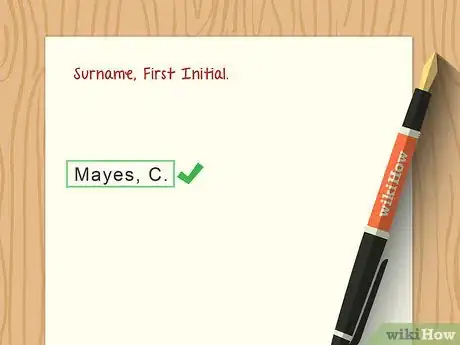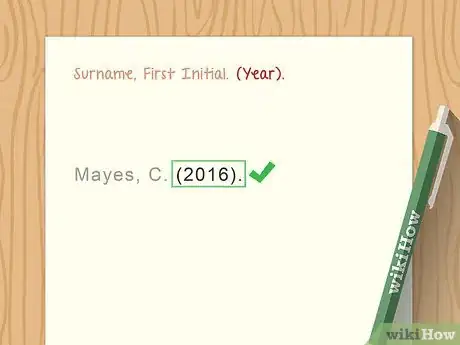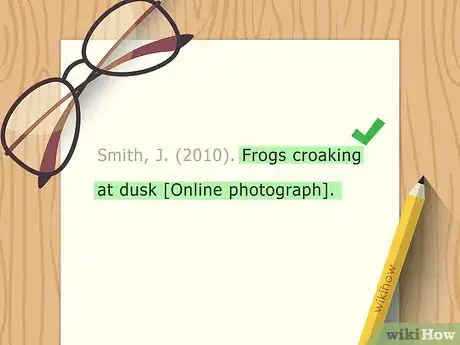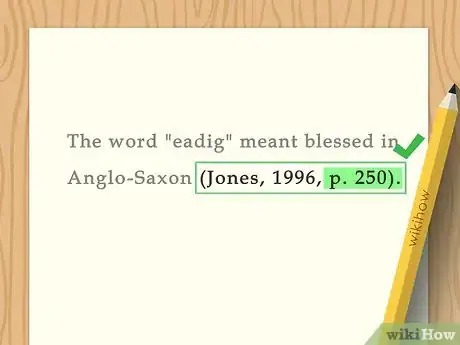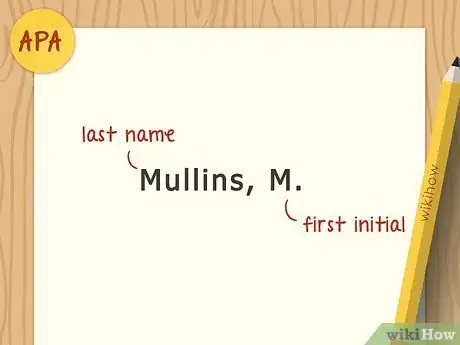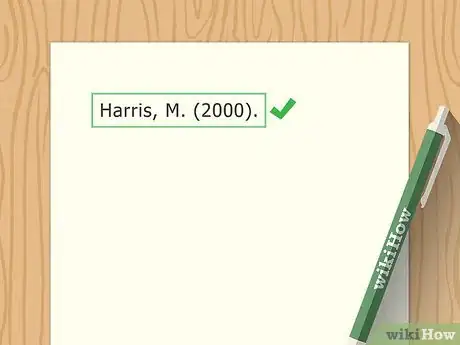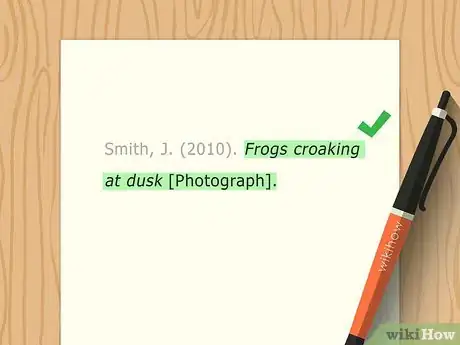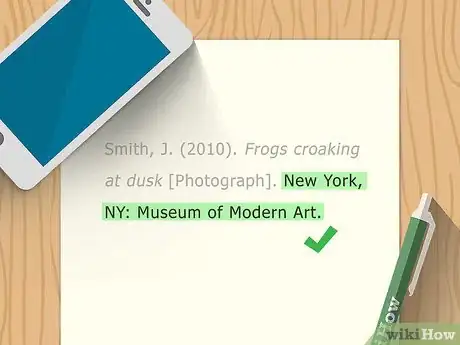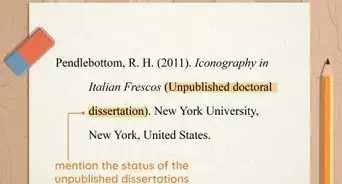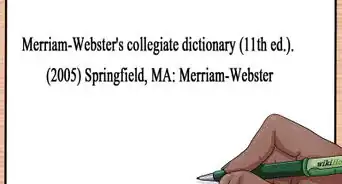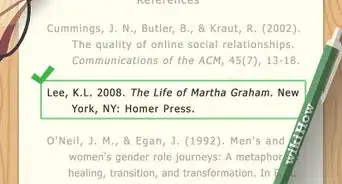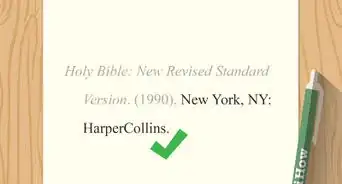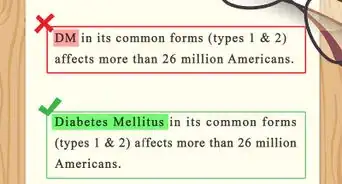This article was co-authored by Cara Barker, MA and by wikiHow staff writer, Jennifer Mueller, JD. Cara Barker is an Assistant Professor and Research and Instruction Librarian at Hunter Library at Western Carolina University. She received her Masters in Library and Information Sciences from the University of Washington in 2014. She has over 16 years of experience working with libraries across the United States.
This article has been viewed 43,818 times.
When you're writing a research paper using American Psychological Association (APA) citation format, you may find that you want to reference a photograph. Although the basic information contained in your citation will be the same, the format differs slightly depending on whether you found that photograph online or in print.[1]
Steps
Citing an Online Image
-
1Gather as much information as possible. When you need to cite a photograph you found online, it may be difficult to find enough information about the photo to create a full citation. You may have to do some additional research to find out more about the photograph.[2]
- Where possible, try to find the original source of the photograph, especially if it was reproduced on another website. If the website doesn't link to the original source, do an image search across the Internet to locate the original.
- In some cases, you may be able to find additional information about a photograph by right-clicking on it.
-
2Start with the photographer's name. An APA citation typically starts with the name of the author. Since the author of a photograph is the photographer, list their name with their last name first, followed by their first and middle initials.[3]
- For example: "Smith, J."
- If you are unable to find the name of the photographer, write the title or a description of the photograph.[4] Begin the citation with the title, such as "Love birds." If there is no title, include a clear description, such as "Photograph of a doe in the forest."
Advertisement -
3List the year the photograph was published or created. Immediately after the name of the photographer, include only the year the photograph was created in parentheses. If you can't find the year of creation, go with the year the photograph was first published online.[5]
- For example: "Smith, J. (2010)."
- Alternatively: "Love birds. (1977)."
-
4Provide the title and format of the photograph. If the photograph has a title, provide that title immediately after the date. Use sentence-style capitalization, capitalizing only the first word of the title and any proper nouns. Then include the phrase "Photograph" in square brackets.[6]
- For example: "Smith, J. (2010). Frogs croaking at dusk [Photograph]."
- If the photograph is untitled, provide a brief description of the photograph in square brackets, beginning with the format. For example: "Smith, J. (2010). [Untitled photograph of croaking frogs]."
- If you cannot find the author's name and started your citation with the title, place a description in the brackets. If you started with a description, simply list the format in brackets.
-
5Include a direct link to the photograph or list the name of the database it came from. Start a sentence with "Retrieved" and copy the URL where the photograph appears. Since online contents can shift, look for a permalink or direct address to use if you can.[7] If you accessed the photograph from a database, include the name of the database in place of the URL and put a period at the end.
- For example: "Smith, J. (2010). Frogs croaking at dusk [Photograph]. Retrieved from http://www.sleepinganimals/pix.com"
- Alternatively: "Love birds. (1977). [Photograph of two doves]. Retrieved from ArtStor."
Citing a Photograph in a Book
-
1Reference the work in which the photograph appears. If you find a photograph in a book that you want to mention in your research paper, provide a citation to the book as a whole, rather than the photograph specifically.[8]
- Follow the APA citation method for the type of print publication where the photograph appears. For a book, you'd use the basic citation for a book. If you found the photograph in a magazine or journal, you'd use the appropriate citation format for that medium.
-
2Provide additional details in your text. When you discuss the photograph in your paper, you can include anything else you consider necessary that wouldn't have been included in the basic reference for the book where the photograph appears.[9]
- For example, if the photographer is important, you might mention their name: "The photographs of Ansel Adams give viewers a better understanding of how the western United States looked before modern development."
- You may also want to include any information about the photograph that differs significantly from the publication information about the book itself. For example, you may find a photograph you want to reference that was taken in 1924, but the book where the photograph appears was published in 2015. Include the photograph's date in your text.
-
3Include the page number in in-text citations. When you cite a photograph in text, your parenthetical citation references the book's author and the year the book was published. Treat a photograph like a direct quote and include a page number.[10]
- For example, an Ansel Adams photograph in a 2015 book by Paul Smith might have the in-text parenthetical citation "(Smith, 2015, p. 24)."
Referencing a Physical Print
-
1State the photographer's name. As the "author" of the photograph, list the photographer's last name, then place a comma and provide their first and middle initials. If the photographer isn't identified, start with the title.[11]
-
2Provide the year the photograph was published or created. For a physical print installation, you typically will find the year the photograph was created on the card next to the display of the print. It may be an estimated year.[12]
- Place the year in parentheses after the photographer's name. For example: "Smith, J. (2010)."
- If the year is unknown, use the abbreviation "n.d." in place of the date. For example: "Smith, J. (n.d.)."
-
3Give the title and medium of the photograph. If the photograph doesn't have a title, provide a brief description of the photograph in square brackets. Otherwise, provide the title of the photograph in italics using sentence-style capitalization, followed by the word "Photograph" in square brackets.[13]
- For example: "Smith, J. (2010). Frogs croaking at dusk [Photograph]."
-
4Include the location of the photograph. Since you've actually looked at a physical print of the photograph, you need to direct your readers to the place where that print is located. Include the geographic location along with the name of the institution or museum. For U.S. locations, provide the city and state. Internationally, include the name of the city and the name of the country.[14]
- For example: "Smith, J. (2010). Frogs croaking at dusk [Photograph]. New York, NY: Museum of Modern Art."
References
- ↑ http://libguides.unitec.ac.nz/apareferencing/images-tables-figures
- ↑ http://libguides.gwumc.edu/c.php?g=27779&p=170351
- ↑ http://libguides.gwumc.edu/c.php?g=27779&p=170351
- ↑ https://blog.apastyle.org/apastyle/2012/05/missing-pieces.html
- ↑ http://libguides.gwumc.edu/c.php?g=27779&p=170351
- ↑ http://libguides.gwumc.edu/c.php?g=27779&p=170351
- ↑ http://libguides.gwumc.edu/c.php?g=27779&p=170351
- ↑ http://libguides.unitec.ac.nz/apareferencing/images-tables-figures
- ↑ http://libguides.fiu.edu/artcite/photorepro
- ↑ http://libguides.unitec.ac.nz/apareferencing/images-tables-figures
- ↑ http://blog.apastyle.org/apastyle/2010/04/theres-an-art-to-it.html
- ↑ http://blog.apastyle.org/apastyle/2010/04/theres-an-art-to-it.html
- ↑ http://blog.apastyle.org/apastyle/2010/04/theres-an-art-to-it.html
- ↑ http://blog.apastyle.org/apastyle/2010/04/theres-an-art-to-it.html
- ↑ https://bowvalleycollege.libguides.com/c.php?g=494959&p=3828594
- ↑ http://libguides.gwumc.edu/c.php?g=27779&p=170351

